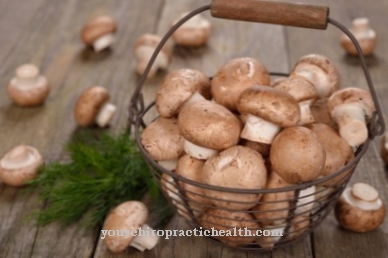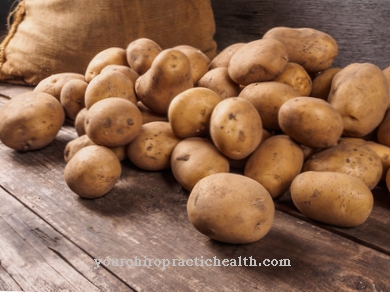milk has always been one of society's staple foods. Whether drunk neat or for cooking and baking - Cow's milk is considered a real all-rounder in the kitchen. As the name suggests, it is obtained from the mammary glands of cows, which are also used to suckle their newborns.
What you should know about cow's milk

The term milk comes from Germanic, similar to whey and milking. The terminology developed from Old and Middle High German. Milk in general is a mammalian nutrient fluid.
In German, “milk” primarily means cow's milk, although other types of milk are also available in stores. This includes goat or soy milk, for example. For other types of milk there is a regulation within the European Union for the specification of the exact name.
Dairy farming began 10,000 years ago when goats and sheep were domesticated. Initially, this was the case in West Asia. The domestication of primeval aurochs began in southeastern Europe 8,500 years ago. In the food industry, mainly cow's milk is traded, from which dairy products such as cheese are also made. In some cultures, dairy products are the main food. This is especially true for pastoral and nomadic people.
In 2008, Germany was third among the countries with the highest milk consumption. Cow's milk is available in supermarkets all year round. To this day there are also milkmen who mostly sell fresh milk separately. This also applies to farmers who take milk from their own cows. Raw milk with a high fat content may only be sold by the producer's farm and is untreated. Preferred milk usually has a little less fat and is available packaged in stores. Whole milk, low-fat milk and skim milk are heat-treated and have a decreasing fat content. In addition, they have a longer shelf life due to said treatment.
Cow's milk has a very distinctive taste, which varies depending on the fat content and is preferred differently.
Importance to health
Due to its fat content, cow's milk has a high number of calories. In the meantime, up to half of the daily calorie requirement is taken in through dairy products. On the other hand, it is not true that milk causes blemished skin - this is only the case in combination with sugar.
Despite its high fat content, cow's milk is healthy for the body in moderation. It contains some important nutrients that the body needs to keep healthy. It is an essential calcium donor that humans need for bones and teeth. It also contains some vitamins and minerals that the body also needs to stay healthy. It has a positive effect on both muscle building and metabolism.
According to some studies, increased milk consumption is said to increase the risk of Parkinson's, although the test results are controversial. The control study carried out in 2011 could not prove this connection.
In addition, studies are said to have treated a link between high milk consumption and prostate cancer. Allegedly, high doses of calcium (> 2000 mg / day) are said to increase the risk of prostate cancer. On the other hand, according to the American Institute for Cancer Research, cow's milk is said to reduce the risk of colon cancer. With raw milk in particular, the germ load of the milk should be taken into account, since infectious diseases such as salmonellosis or intestinal tuberculosis can occur.
All in all, normal consumption of cow's milk is healthy and can be consumed without hesitation.
Ingredients & nutritional values
| Nutritional information | Amount per 100 gram |
| Calories 42 | Fat content 1 g |
| cholesterol 5 mg | sodium 44 mg |
| potassium 150 mg | carbohydrates 5 g |
| protein 3.4 g | vitamin C 0 mg |
Cow's milk consists of almost 90% water. Otherwise it contains around 5% carbohydrates, around 4% milk fat and 3.5% protein. Cow's milk contains 4.6% lactose - that is, milk sugar. Depending on the processing and heating level, the fat content in cow's milk is influenced. Raw milk contains on average 4.2% fat, while the lowest fat level is only 0.5%. Due to the heat treatment, low-fat milk only has between 1.5 and 1.8% fat.
Intolerances & allergies
In Europe around 90% of the population can tolerate cow's milk. However, only a third of people worldwide can drink milk without symptoms. This is particularly the case in Southeast Asia. Humans lack the necessary enzyme to process the lactose they contain. The sugar contained is not tolerated, which is known as lactose intolerance. The consequences are flatulence and abdominal pain as the sugar ferments in the colon.
Other symptoms can include increased belching, nausea, migraines, circulatory problems or colic. Almost everyone can tolerate milk in infancy - albeit mostly breast milk. At this age, the enzyme lactase is still produced in sufficient quantities. However, this decreases with age. For some people even completely. In Europe, however, a gene mutation led to increased tolerance. Since people used to be dependent on milk, there was an oversupply, which is what is now tolerable.
Shopping & kitchen tips
Despite the higher exposure, people who are particularly health-conscious should use raw milk. In the process of preservation, some nutrients are either partially or completely lost.
However, attention should be paid to consuming it quickly, as it can only be kept for a few days. Those who do not want this should prefer whole milk to skimmed milk. In general, the best-before date for milk should not be exceeded. Once opened, it can be used up quickly, otherwise it will turn sour. Long-life milk can be stored in a dark cupboard or pantry after shopping. If it is opened, however, it must be put in the refrigerator. All other fat variations should be stored in the refrigerator from the start. The same goes for all other dairy products.
They are sensitive to air, light and heat. Among other things, light reduces the vitamin content and deteriorates the taste. In addition, cow's milk should not be stored next to strongly smelling foods as it can easily absorb odors. This also falsifies the taste.
Preparation tips
Cow's milk is used as an ingredient in a wide variety of dishes and desserts. It is used, for example, for the preparation of various cakes, waffles or pancakes and, in combination with flour and sugar, gives the necessary consistency. In addition, cow's milk is used to boil rice pudding.
Otherwise, quark can also be made from milk. A wide variety of dairy products can be found in stores. Including a wide variety of cheeses that are produced using different methods. Yogurt is also made from milk.Mascarpone, tartar sauce and sour cream are just as indispensable in the kitchen as whipped cream or buttermilk. Some of it can be made at home.
You can also make your own ice cream with milk, fruit and ice cream in summer. Not only does it often taste better than bought ice cream, but it is also a lot healthier because you can determine the sugar content yourself. Chocolate or vanilla can also be added to make sweeter flavors of ice cream yourself. Another popular option is milkshakes, which are also made with fruit.



























